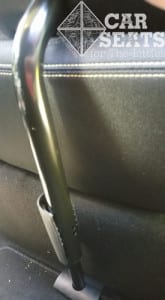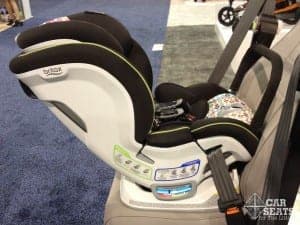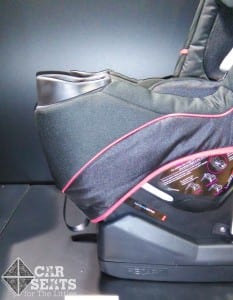
Cybex Aton 2 load leg
It used to be that anti-rebound bars and load legs were common only in Canada and outside North America. But today these features are becoming more and more common for seats on the American market as well. In Canada, car seat manufacturers often employ the anti-rebound bar to meet Canada’s anti-rebound standards. But what exactly are these, and what do they do?
The anti-rebound bar and the load leg perform essentially the same function on rear facing only and rear facing convertible car seats, though in different ways. As more caregivers request these features, car seat manufacturers are offering them more often. However, even the parents requesting them may not completely realize what they do or how they help. CSFTL is here to translate for you!
First, Physics!
During a crash, a car seat (and everything else in the vehicle) will rotate or move toward the point of impact. Car seats are tested with a frontal impact as the standard, so we’ll focus on that kind of crash.
During the initial impact, the car seat rotates toward the front of the car. Then as the crash continues the car seat rebounds back into the back seat. This sounds remarkably alarming to parents hearing it and visualizing it for the first time. Please, don’t panic. Our bodies do this as well, and auto manufacturers figured out a long time ago that adding padding behind the person reduces injury. So, rear facing kids aren’t hitting the wooden benches of cars of old, they’re hitting a well padded and protected frame for the back seat. Rebound generally is not a concern, and we don’t see many injuries from it at all.
Anti Rebound Bars

Britax Boulevard with Anti Rebound Bar
Anti rebound bars reduce the movement of the car seat as it goes back into the vehicle’s back seat. The car seat rotates toward the front of the car as expected during the crash, but when the seat rebounds toward the back of the car, the bar catches on the backseat and halts that rebound. Because the vehicle’s seat is padded it is not a sudden stop, but instead comes to a stop before the car seat would have without the added anti-rebound bar.
What About Vehicle Restrictions?

RECARO anti-rebound bolster
There are no vehicles that restrict the use of car seats with anti-rebound bars. The only issue with an anti-rebound bar is that they may increase the front to back footprint of the car seat, or they may not quite fit easily in the contours of the back seat. Some car seats require anti rebound bars to be used, some have optional bars, and some have anti rebound devices integrated into the seat or base, so there’s no question of whether or not they can be used.
Load Legs and Vehicle Limits
While we see anti rebound bars on both rear facing only and convertible car seats in the United States, load legs are primarily available on rear facing only car seats. They’re attached to the base of the seat, rather than the carrier portion of the car seat.
Load legs work to reduce the initial movement towards the point of impact in a crash. By reducing that movement forward, load legs also reduce rebound as the crash continues: less movement forwards means less rebound as the crash continues. Cars with angled floors right in front of the back seat where the load leg hits, or with under-floor storage where the load leg sits cannot use the load leg. In the United States, all load legs are optional. They can either be tucked away or removed when not in use.
In Summary
Anti rebound bars and load legs are both nice features that are becoming more and more common. We applaud their use, but want to remind parents that rebound in and of itself is not a cause for concern. If your child’s car seat does not have a method of anti-rebound, please do not feel that you are doing your child a disservice. All seats on the U.S. market pass the same very stringent testing and children in properly used rear facing seats are very safe. Features above and beyond that are left to the parent to make the decision if they’re worth the money for their family.
